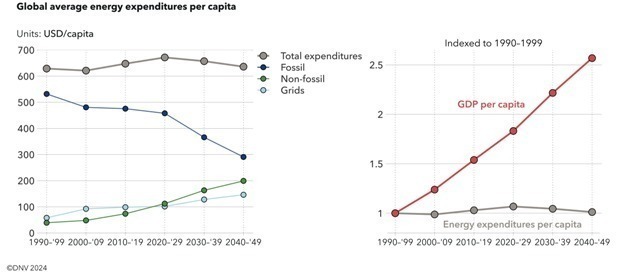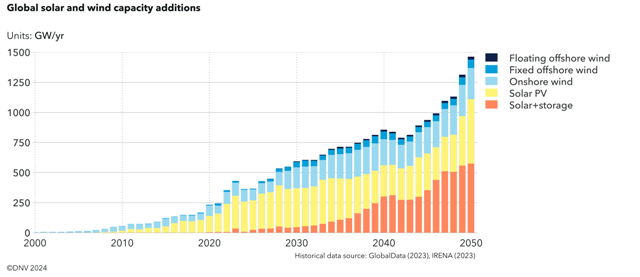The world’s electricity demand is set to double by 2050 as reliance on fossil fuels diminishes, according to a recent report by DNV, an independent energy expert and assurance provider.
The report, titled “New Power Systems,” highlights the necessary steps and challenges for achieving a decarbonized energy system. Readers can download the report.
Key Drivers of Growing Electricity Demand
The report identifies global economic growth and the electrification of transportation, heating, and industry as primary drivers of the anticipated surge in electricity demand. Additionally, the development of data centers, especially for AI applications, is expected to contribute significantly to this increase. By mid-century, electricity will make up 37 percent of global final energy use, up from 20 percent in 2023.
Shift Towards Renewable Energy
The transition to renewable energy is a central theme in the report. By 2040, wind and solar power are expected to generate half of the world’s electricity, and by 2050, this figure is projected to reach 70 percent. The report predicts that nearly 90 percent of electricity will come from non-fossil sources by 2050.

Flexibility and Demand-Response
The increasing share of renewable energy sources requires a robust system of flexibility and demand-response. As variable renewable energy sources expand ninefold, the need for short-term flexibility will double. New ancillary services, such as synthetic inertia products and fast frequency response, will be critical. Market and regulatory frameworks must adapt to support these technologies, ensuring a sustainable energy future.
Advanced technologies, including AI, will play a crucial role in managing the complexity of a renewable-dominated power system. Remi Eriksen, Group President and CEO at DNV, emphasized the importance of digitalization: “Deep digitalization, including the application of AI, is crucial for managing the increased complexity of a renewable-dominated power system.”
Energy Storage and Grid Expansion
Energy storage is essential for addressing the intermittent nature of renewable energy, providing grid balancing, and managing load. Lithium-ion batteries are set to dominate this segment, offering three times more storage capacity than hydropower and pumped storage by 2050. Achieving the necessary level of flexibility will require innovative market designs and advanced tariff schemes to incentivize automated demand-response, vehicle-to-grid (V2G), and behind-the-meter storage systems.
Grid expansion is another critical component. Global grid capacity needs to grow 2.5 times its current size, with annual expenditure on grids more than doubling to USD 970 billion by 2050. Despite the rise in global grid expenditures, efficiencies in grid technology and increased electricity distribution are expected to keep consumer grid charges stable or declining in most regions.
Systemic Approach to Energy Transition
DNV’s report emphasizes the importance of a systemic approach to the energy transition. Ditlev Engel, CEO for Energy Systems at DNV, stated: “There will be no transition without transmission. The new energy system will require data-driven solutions and policies that address all interconnections, from permitting to the integration of AI and cyber-resilience.”
The report calls for significant investment, innovation, coordination, and commitment from all players, especially governments, to achieve a decarbonized power system. As the world moves towards a greener future, addressing these challenges with a forward-thinking approach will be essential for a successful energy transition.
Baburajan Kizhakedath

